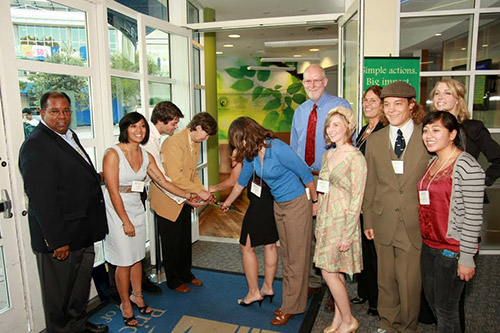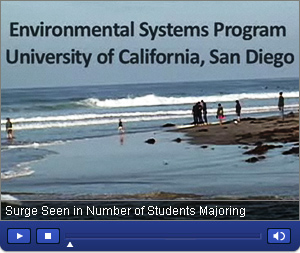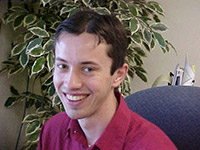UC San Diego Students Gravitating to ‘Green’ Majors, Courses and Internships
Rex Graham | December 14, 2009
From energy economics and sustainable building designs to water conservation and biofuels made from algae, sharply higher numbers of UC San Diego undergraduates are opting for majors and minors, classes, internships and research projects that emphasize environmental sustainability.
This year alone, the number of students minoring in Environmental Studies doubled to 60 and Environmental Engineering majors increased 50 percent to 92. In the eight years since the Division of Physical Sciences created the Environmental Systems major, enrollment has grown from a handful of students to more than 200 registered this fall.

The ribbon-cutting ceremony during the Sustainability Resource Center opening. (Photo / Jonathan Lee)
Even individual classes with green themes are popular. For example, more than 250 students enrolled in Economics of Conservation when the Department of Economics first offered the course in 2008-09. Another environmental class offered for the first time this year, Global Carbon Science and Politics – The Road from Copenhagen, quickly reached the maximum enrollment of 60 students. Others eager to take the course were put on a waiting list.
Greater interest in sustainability is evident among UC San Diego undergraduates in all six colleges and every school and department. Experienced faculty members say they haven’t seen such fervor since the peace and civil rights movements of the 1960s and ’70s. The spirited opening celebration in November of the university’s new Sustainability Resource Center was led by members of the Student Sustainability Collective, a student-financed and student-run group now housed in the center. The collective’s six teams work on activism and community outreach related to water conservation, public transportation, urban development, waste and energy, civil and human rights, and sustainable foods.
“Almost every day, students remind me and other university leaders and faculty that they want more opportunities to make a positive difference in the environmental stewardship of the campus, the surrounding community and the planet,” said Chancellor Marye Anne Fox. “We’re already one of the greenest campuses in the nation, but our students are continually pushing the campus to do more, and they’ve demonstrated an eagerness to contribute their time and energy to make it happen.”
Read related stories on UC San Diego gravitating towards Green:
Five years ago, Fox and top campus leaders named environmental sustainability one of UC San Diego’s top educational, research and operational priorities. As a result, every campus light bulb has been, or is being, replaced with the most energy-efficient fluorescent bulbs. Photovoltaic panels have sprouted like high-tech trees from buildings and parking garages, and the university is preparing to build a 2.8-megawatt fuel cell that will run on methane gas from the city of San Diego’s Point Loma Wastewater Treatment Plant. The campus is moving toward operating only low- and zero-emission vehicles in its 800-vehicle fleet. The campus will use 4 megawatts of renewable energy by 2010 and has goals of achieving zero waste and carbon neutrality by 2025.

UC San Diego has transformed itself into a living laboratory in which all campus facilities and operations are being redesigned to lessen their impact on the environment. Seven student “econauts” have been hired by Housing and Dining Services to provide peer-to-peer education about individual ways students can reduce their carbon footprint and help the university meet its sustainability goals.
One of the first students to graduate from the Environmental Systems program, John Quenzer ’02 now manages projects for D-Max Engineering, a San Diego-based environmental consulting company that specializes in storm water management. Quenzer said the program prepared him well for the job, which he has held for more than five years. “The field is a good fit with environmental systems,” he said. “We have to interpret permits and understand policy, analysis, science, and statistics. It’s interdisciplinary. You have to be adaptable.”
Jane Teranes, associate director of the Environmental Systems program, said some of the toughest environmental policy decisions require a solid understanding of the science involved. In addition to a rigorous background in natural sciences and policy, students in the Environmental Systems program are required to participate in a yearlong environmental internship and research project.

Among the first to graduate from the Environmental Systems program, John Quenzer ’02 helps San Diego area businesses keep pollution out of storm drains. (Photo courtesy / John Quenzer)
Requirements for degrees in all green programs are challenging. Undergraduates in the Environmental Engineering program, in the Department of Mechanical and Aerospace Engineering, obtain solid skills in mathematics, physics, fluid mechanics and environmental transport, as well as heat and mass transfer in complex geometries.
“Many new environmental engineering and sustainability challenges require strong quantitative skills,” said Jan Kleissl, an environmental engineering professor. “Our majors are well versed in engineering skills critical for the new low-carbon economy. From energy efficient buildings, to solar power, smart grids and water conservation, our students know the issues, the engineering methods and the solutions.
The Division of Social Sciences has filled-to-capacity classes with environmental content in the departments of Economics, Ethnic Studies, Sociology and Urban Studies. An increasing number of student projects in those departments also focus on sustainability.
Urban Studies and Planning (USP), one of the oldest interdisciplinary undergraduate majors at UC San Diego, underwent a major greening of its curriculum in 2002-3. New classes such as “Sustainable Planning” were added to complement existing courses like “Sustainable Development.”
The number of USP majors – many of them environmentally oriented – has grown from 78 in 2001 (before the curriculum change) to 170 in 2009, said USP Program Director Steve Erie. Seniors are increasingly choosing to focus on sustainability topics in their research practicum requirement.
“The type of environmental projects that USP students do have a strong field research and service learning component,” said Keith Pezzoli, the USP program’s field studies supervisor who teaches the senior sequence. “The diversity of their projects is impressive – including landscape ecology, greening of buildings, regional habitat conservation planning, integrated watershed management, climate change, environmental justice and policy-making, among a wide range of other topics.”
The Environmental Studies minor was established nearly two decades ago in John Muir College, one of UC San Diego’s six colleges, to give a broad interdisciplinary perspective on the environmental aspects of any field of study. Students can choose between a natural sciences track or another that emphasizes the social sciences and humanities. A new course added this year, “Wilderness and Human Values,” was inspired by naturalist John Muir and teaches students the meaning of wilderness and nature today. “It was great to take a course that involved field work and outdoor trips,” said Nick Starvos, a Sixth College junior and Environmental Studies minor.
More environmentally conscious students seek challenging experiences outside of the classroom in the form of research and internship opportunities. Since its inception five years ago, undergraduates who work part time as Green Campus Interns have conducted energy audits of campus buildings, helped reduce paper usage in campus printing jobs and helped the university complete the arduous application process that led this month to LEED (Leadership in Energy and Environmental Design) silver certification for the university’s Campus Services Complex, the first such designation for an existing structure on the UC San Diego campus.
The approximately $11 hourly wage for the Green Campus Interns program comes from the Alliance to Save Energy, a project of California’s investor-owned utilities. “All the interns are doing this because they believe in it,” said Michelle Perez, an advisor to the interns and a sustainability analyst with the Auxiliary & Plant Services Department. “It’s not a job to them.”
Kate Ziemba, a senior majoring in Environmental Systems, played a key role in the recent LEED silver certification of the Campus Services Complex while working part time as a Green Campus Intern. “Students take classes related to sustainability, but they want more,” she said. In a separate project to fulfill the requirements for her major, Ziemba interned with the Coast Law Group in Encinitas, Calif. “It’s great to see the work the firm does and imagine myself doing this in a few years.”
In the Division of Biological Sciences, eight undergraduates are involved in research projects to turn algae into biofuels. Steve Kay, dean of the division, is one of five biology professors working on algal biofuel research projects that have a connection to the San Diego Center for Algae Biotechnology, a local consortium of companies and research institutions seeking to make production of algal biofuels an economic reality. “We have several new programs in place that specifically connect our undergraduate students to our local biotechnology community,” Kay said.
“With a weekday population of about 50,000, the university is very much like a small city, but most of our residents, from faculty and staff to students, share a common commitment to becoming a zero-waste, carbon-neutral community,” said Chancellor Fox. “When our students graduate they will take this commitment with them no matter what career path they take.”

|